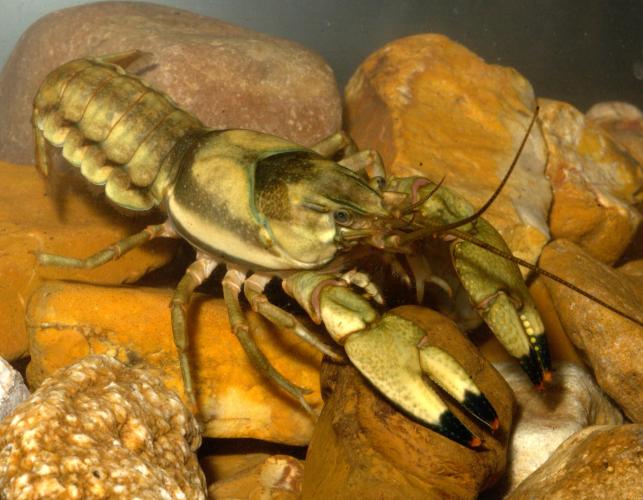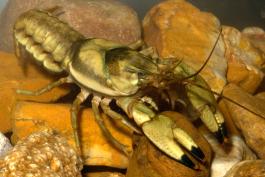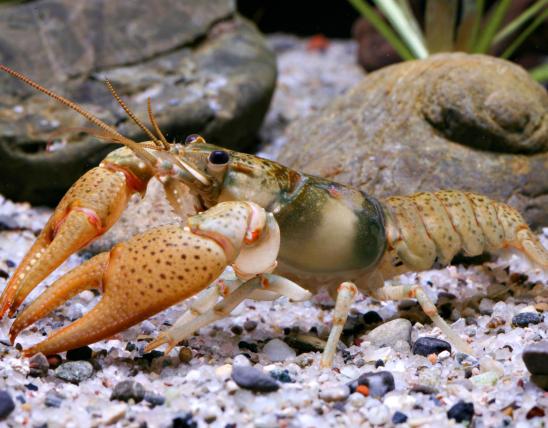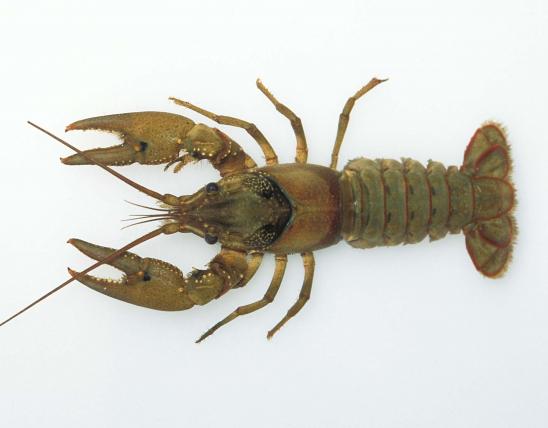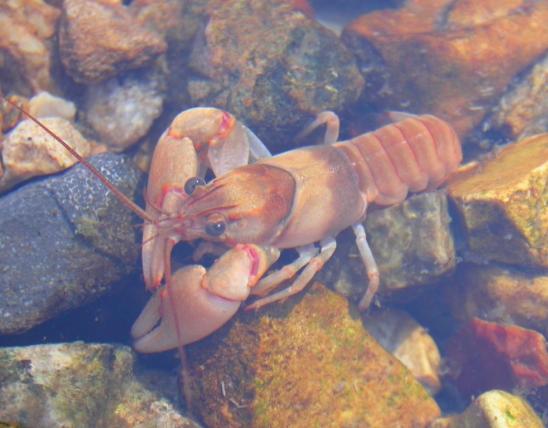
The ringed crayfish is a medium-sized, olive-green to reddish-tan crayfish with prominent black or brown rings around the fingers of its pincers near the tips. The pincers are often very broad and heavy (especially in males) with a broad gap between the fingers when they are closed. A dark band crosses the carapace near its junction with the abdomen. A pair of dark stripes run lengthwise along the abdomen near its lateral (side) margins. No other crayfish within the range of this species has conspicuous black rings on the fingers.
Two subspecies occur in Missouri:
- the ringed crayfish, F. n. neglectus, in the Spring (Neosho) River basin, is olive green with orange pincer tips with a black ring.
- the gap-ringed crayfish, F. n. chaenodactylus, in the North Fork and Bryant Creek drainages, is reddish tan with broad brown rings on the pincer tips.
- populations in intervening streams of the White River basin show a mixture of the characteristics used to separate the two and are considered intergrades.
Similar species: The Ozark crayfish is often found in the same streams; it has about the same size and build but has numerous dark specks on the abdomen and pincers.
Adult length: about 1½ to 3½ inches.
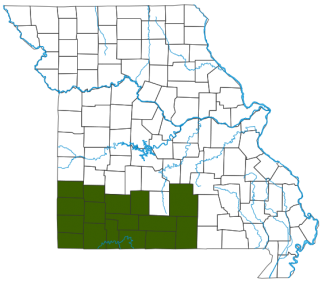
Southwestern Ozark region of Missouri, from the North Fork of the White River in Howell County westward through the White and Spring (Neosho) River basins. It has been introduced into the Spring River and Eleven Point River systems, where it is invasive.
Habitat and Conservation
Occurs in clear, rocky, permanent-flowing streams ranging in size from small creeks to large rivers. It occurs in rocky riffles and shallow pools having sufficient current to keep the bottom largely free of silt. This crayfish excavates cavities in gravel beneath large rocks. Where it occurs, it is the most abundant crayfish.
Food
Forages at night on algae and detritus. Crayfish are generally omnivores, eating a wide variety of plant and animal materials.
Status
Populations of the ringed crayfish are apparently secure in their native streams.
Unfortunately, this species has been introduced into the Spring River and Eleven Point River drainages (where is is not native), resulting in declines of native crayfish populations, including the critically imperiled coldwater crayfish. The ringed crayfish is therefore considered invasive in the Spring River and Eleven Point River.
Life Cycle
Breeding occurs from October to April and eggs are laid in the spring. Females carry eggs March through June, apparently peaking in April in warmer streams, but later in cooler, spring-fed streams. The young reach about 2 inches in length by the end of their first growing season. Most ringed crayfish live about 2½ years, though some can live as long as 5 years.
Human Connections
In addition to feeding many types of wildlife, crayfish provide food for many species that humans hunt and fish. Crayfish commonly serve as fish bait, and many people eat crayfish, too. Crayfish are fascinating, colorful creatures and are part of our rich native heritage.
It can be hard for people to understand how a native Missouri species can also be invasive. The political borders of our state mean little to animals confined to aquatic habitats. Because crayfish and other aquatic animals usually cannot travel over land, they are often confined to specific river systems. When people move them artificially from one body of water to another that they didn't belong in naturally, they can become invasive, outcompeting or displacing the organisms native to that aquatic system.
Ecosystem Connections
Crayfish are an important link in the food chain between plants and other animals, breaking down plant materials that are resistant to decay. Crayfish in turn are an important food for many other animals. Presence of crayfish in a stream or pond usually indicates good water quality.
